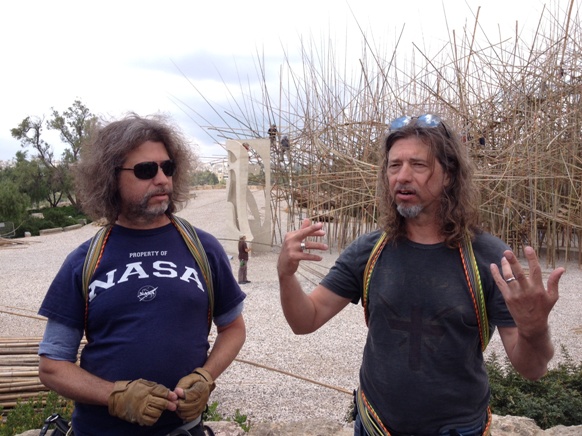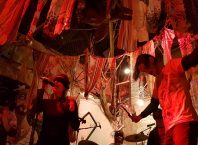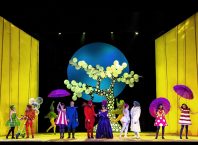Up close, it first seems like an impenetrable thicket, dried bamboo lashed together with brightly coloured laces. But suddenly, a path becomes apparent through the confusion. It starts at the ground, wends its way upwards to a vertiginous height, loops and doubles back on itself. Order, it seems, can be shaped out of chaos and apparent disorder. The important thing, I suppose, is knowing where to look…

Big Bambú: 5,000 Arms To Hold You, an installation in progress at the Israel Museum, is the latest manifestation of a kinetic, organic installation by the Starn Twins, previous appearances including the roof of New York’s Metropolitan Museum of Art and the Venice Biennale.

“It’s a performance piece, not just a sculpture,” Mike Starn explained at a press conference to unveil the project in Jerusalem last week. Identical twins from New Jersey, the Starns have a long-founded relationship with the passage of time and the uniqueness of individual perspective. “You are watching an organism grow – culture, society, a multitude of things that make up every part of us every day, the interconnections that create structure.”
The connection is obvious, but not at all pedantic. Bamboo combines the appearance of fragility with strength and durability; 5,000 Arms…looks as though it is liable to be blown over at any moment, but is in fact remarkably resilient. Created by the Starns and a crew of 25 rock climbers (once you see the structure, you’ll understand exactly why), the installation will continue to evolve over the course of its residency at the museum. It’s an intricate, complicated affair, planned to the nth degree – the bamboo is specifically sourced in Georgia and South Carolina, and the seemingly quaint laces have a specific representational purpose too. “They show up the interconnections, often invisible, that bring the disparate parts of Iives together,” explains Elizabeth, a long-term member of the Starn’s travelling team.

When complete, 5,000 Arms… will stand 16 metres high, the winding path that will wend its way through it open to members of the public. The idea, I sense, will be to experience the contradiction between the delicateness of a single life and the strength that we can – we don’t always manage to do so, but we can – draw from others. From a distance, the bamboo arms look like spindly fingers, stretched skywards in supplication to the heavens. Given its location, in the heart of Jerusalem, it seems at once both contradictory, yet somewhat apt. Jerusalem is chock-a-block with God-botherers of all persuasions. But perhaps we ought to rely more upon each other than upon the ineffable?
Big Bambu: 5,000 Arms to Hold You, The Israel Museum Jerusalem, June 10 – October 1, 2014
Israel Museum website





